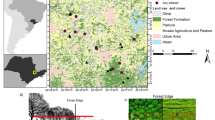Abstract
Three types of landscape boundary (forest/pepper field, forest/cabbage field, and forest/grassland) were selected in the aird valley of upper reaches of Minjiang River, southwestern China. On the basis of vegetation diversity, the depth of edge influence (DEI) on different types of landscape boundaries was estimated using principal components analysis (PCA) method and moving split-window techniques (MSWT). The results showed that in the 5 transects, PCA method was able to detect the edge influence depth with 3 transects, while MSWT could explain 4 transects. It is concluded that PCA and MSWT both can be used to detect the depth of edge influence within 50 m from the edge to the interior. Similar conclusions were drawn in the forest of each transect with the two methods, but no similar conclusions were drawn in the pepper field of each transect. Although the two methods have advantages and disadvantages respectively, they are useful tools for characterizing edge dynamics. Comparing the two methods, MSWT is more successful.
Similar content being viewed by others

References
Brunt, J.W. and Conley, W. 1990. Behavior of a multivariate algorithm for ecological edge detection [J]. Ecological Modelling.49: 179–203.
Cadenasso, M.L., Pickett, S.T.A., Weathers, K.C.,et al. 2003. An interdisciplinary and synthetic approach to ecological boundaries [J]. BioScience,53: 717–722.
Chang, Y., Bu, R.C, Hu, Y.M.,et al. 2003. Detecting forest landscape boundary between Mountain Birch and evergreen coniferous forest in the northern slope of Changbai Mountain [J]. Journal of Environmental Sciences,15: 182–186.
Chen, J. and Franklin, J.F. 1992. Vegetation responses to edge environments in old-growth Douglas-fir forests [J]. Ecological Application,2: 387–396.
Chen, J., Franklin, J.F. and Lowe, J.S. 1996. Comparison of abiotic and structurally defined patch patterns in a hypothetical forest landscape [J]. Conservation Biology,10: 854–862.
Choesin, D. and Boerner, R.E.J. 2002. Vegetation boundary detection: a comparison of two approaches applied to field data [J]. Plant Ecology,158: 85–96.
Editorial Board of Sichuan Vegetation. 1980. Sichuan Vegetation [M]. Chengdu: Sichuan People's Press, p55–89. (in Chinese)
Fagan, W.F., Fortin, Marie-Josee. and Soykan, C. 2003. Integrating edge detection and dynamic modeling in quantitative analyses of ecological boundaries [J]. BioScience,53: 730–738.
Guo Yongming, Tang Zongxiang, Tang Shijia,et al. 1993. Protective utilization of soil resources in the upper reaches of the Mingjiang River [J]. Mountain Research,11: 251–256. (in Chinese)
Jin Sen, Zhou Xiaofeng and Guo Qingxi. 2002. Edge detectin, between boreal forest and temperate forest in China [J]. Acta Phytoecologica Sinica,26(5): 561–567. (in Chinese)
Johnston, C.A., Pasto, R.J. and Pinay, G. 1992. Quantitative methods for studying landscape boundaries [C] In: Hansen, A.J., di Castri, F. (eds.) Landscape boundary-consequence for biotic diversity and ecological flow. New York: Springer-Verlag Press Inc., 107–125.
King, J.R. and Jackson, D.A. 1999. Variable selection in large environmental data sets using principal components analysis [J]. Environmetrics,10: 67–77.
Krummel, J.R., Gardner, R.H., Sugihara, G.et al. 1987. Landscape patterns in a disturbed enviroment [J]. Oikos,48: 321–324.
Liu Wenbin. 1994. Main types of the semi-arid valley scrubs in the upper reaches of the Minjiang River [J]. Mountain Research,12: 37–31. (in Chinese)
Matlack, G.R. 1993. Microenvironment variation within and among forest edge sites in the eastern united states [J]. Biological Conservation,66: 185–194.
Murcia, C. 1995. Edge effects in fragmented forests: implications for conservation [J]. Tree,10: 58–62.
Paster, J., Broschart, M. 1990. The spatial pattern of a northern conifer-hardwood landscape [J]. Landscape ecology,4: 55–68.
Shi Peili and Liu Xingliang. 2002. The application of moving split-window technique in determining ecotone: a case study ofabies faxoniana timberline in Balang Mountain in Sichuan Province [J]. Acta Phytoecologica Sinica,26: 189–194. (in Chinese)
Strayer, D.L., Power, M.E., Fagan, W.F.,et al. 2003. A classification of ecological boundaries [J]. BioScience,53: 723–729.
Sun Shucun and Liu Zhaoguang. 1997. Study on the patterns ofconvolvulus tragacuthoiedes population in the upper reaches of the Mingjiang River [J]. Chinese Journal of Applied & Environmental Biology,3: 193–198. (in Chinese)
Tong Chengli and Li Shendian. 1996. Production potential of farmland in semi-arid area of the upper basin of Mingjiang River [J]. Resources and Environment in the Yangtze Valley,5: 335–339. (in Chinese)
Wittrock, V. and Ripley, E.A. 1999. The predictability of autumn soil moisture levels on the Canadian prairies [J]. International Journal of Climatology,19: 271–289.
Author information
Authors and Affiliations
Additional information
Foundation item: This work was financially supported by the Major State Basic Research Program of China (973 Program: 2002CB111506).
Biography: Li Liguang (1973-), female, Ph. Candidate in the Institute of Applied Ecology, Chinese Academy of Sciences, Shenyang 110016, P. R. China.
Responsible editor: Zhu Hong
Rights and permissions
About this article
Cite this article
Li-guang, L., Xing-yuan, H., Xiu-zhen, L. et al. Comparison of two approaches for detecting the depth of edge influence on vegetation diversity in the arid valley of southwestern China. Journal of Forestry Research 16, 105–108 (2005). https://doi.org/10.1007/BF02857900
Received:
Issue Date:
DOI: https://doi.org/10.1007/BF02857900
Keywords
- Boundary
- Moving split-window techniques (MSWT)
- Principal components analysis (PCA)
- Depth of edge influence (DEI)



